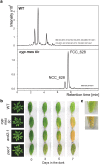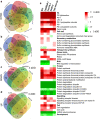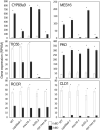Side-chain modifications of phyllobilins may not be essential for chlorophyll degradation in Arabidopsis
- PMID: 36035897
- PMCID: PMC9399834
- DOI: 10.1002/pld3.441
Side-chain modifications of phyllobilins may not be essential for chlorophyll degradation in Arabidopsis
Abstract
Disposing efficiently and safely chlorophyll derivatives during senescence requires a coordinated pathway that is well conserved throughout green plants. The PAO/phyllobilin pathway catalyzes the degradation of the chlorophyll during senescence and allows detoxification of the pigment and its subsequent export from the chloroplast. Although most of the chloroplastic reactions involved in chlorophyll degradation are well understood, the diversity of enzymes responsible for downstream modifications of non-phototoxic phyllobilins remains to be explored. More than 40 phyllobilins have been described to date, but only three enzymes catalyzing side-chain reactions have been identified in Arabidopsis thaliana, namely, TIC55, CYP89A9, and MES16. Here, by generating a triple mutant, we evaluate the extent to which these enzymes are influencing the rate and amplitude of chlorophyll degradation at the metabolite as well as its regulation at the transcriptome level. Our data show that major side-chain modifications of phyllobilins do not influence significantly chlorophyll degradation or leaf senescence, letting the physiological relevance of their striking diversity an open question.
Keywords: Arabidopsis thaliana; CYP89A9; MES16; TIC55; chlorophyll; phyllobilins; senescence.
© 2022 The Authors. Plant Direct published by American Society of Plant Biologists and the Society for Experimental Biology and John Wiley & Sons Ltd.
Conflict of interest statement
The authors have no conflict of interest.
Figures





Similar articles
-
A Role for TIC55 as a Hydroxylase of Phyllobilins, the Products of Chlorophyll Breakdown during Plant Senescence.Plant Cell. 2016 Oct;28(10):2510-2527. doi: 10.1105/tpc.16.00630. Epub 2016 Sep 21. Plant Cell. 2016. PMID: 27655840 Free PMC article.
-
Characterization of the pheophorbide a oxygenase/phyllobilin pathway of chlorophyll breakdown in grasses.Planta. 2018 Oct;248(4):875-892. doi: 10.1007/s00425-018-2946-2. Epub 2018 Jun 27. Planta. 2018. PMID: 29951845
-
A liquid chromatography-mass spectrometry platform for the analysis of phyllobilins, the major degradation products of chlorophyll in Arabidopsis thaliana.Plant J. 2016 Nov;88(3):505-518. doi: 10.1111/tpj.13253. Epub 2016 Sep 8. Plant J. 2016. PMID: 27349589
-
Phyllobilins as a challenging diverse natural product class: Exploration of pharmacological activities.Arch Pharm (Weinheim). 2021 Oct;354(10):e2100061. doi: 10.1002/ardp.202100061. Epub 2021 Jun 21. Arch Pharm (Weinheim). 2021. PMID: 34155668 Review.
-
Chlorophyll Degradation and Its Physiological Function.Plant Cell Physiol. 2025 Feb 28;66(2):139-152. doi: 10.1093/pcp/pcae093. Plant Cell Physiol. 2025. PMID: 39172641 Review.
Cited by
-
A Chlorophyll-Derived Phylloxanthobilin Is a Potent Antioxidant That Modulates Immunometabolism in Human PBMC.Antioxidants (Basel). 2022 Oct 19;11(10):2056. doi: 10.3390/antiox11102056. Antioxidants (Basel). 2022. PMID: 36290779 Free PMC article.
-
Dynamic identification of candidate genes associated with higher tocopherol biosynthesis in Brassica napus seeds.Front Plant Sci. 2025 Jun 5;16:1613360. doi: 10.3389/fpls.2025.1613360. eCollection 2025. Front Plant Sci. 2025. PMID: 40538874 Free PMC article.
-
Identification of Photosynthesis Characteristics and Chlorophyll Metabolism in Leaves of Citrus Cultivar (Harumi) with Varying Degrees of Chlorosis.Int J Mol Sci. 2023 May 7;24(9):8394. doi: 10.3390/ijms24098394. Int J Mol Sci. 2023. PMID: 37176103 Free PMC article.
References
-
- Aubry, S. , Fankhauser, N. , Ovinnikov, S. , Pružinská, A. , Stirnemann, M. , Zienkiewicz, K. , Herrfurth, C. , Feussner, I. , & Hörtensteiner, S. (2020). Pheophorbide a may regulate Jasmonate signaling during dark‐induced senescence. Plant Physiology, 182, 776–791. 10.1104/pp.19.01115 - DOI - PMC - PubMed
-
- Chou, M.‐L. , Liao, W.‐Y. , Wei, W.‐C. , Li, A. , Chu, C.‐Y. , Wu, C.‐L. , Liu, C.‐L. , Fu, T.‐H. , & Lin, L.‐F. (2018). The direct involvement of dark‐induced Tic55 protein in chlorophyll catabolism and its indirect role in the MYB108‐NAC signaling pathway during leaf senescence in Arabidopsis thaliana . International Journal of Molecular Sciences, 19, 1854. 10.3390/ijms19071854 - DOI - PMC - PubMed
LinkOut - more resources
Full Text Sources
Molecular Biology Databases

